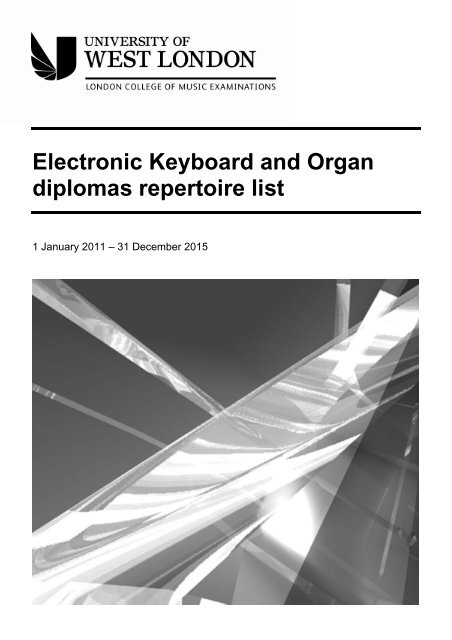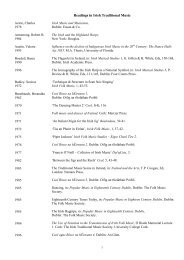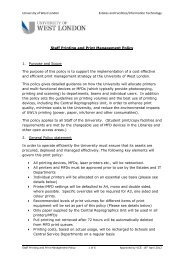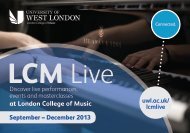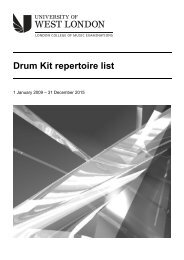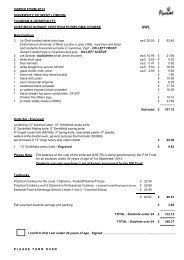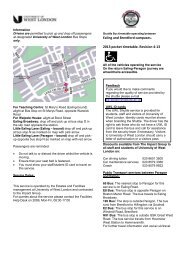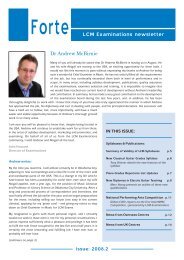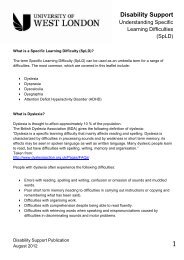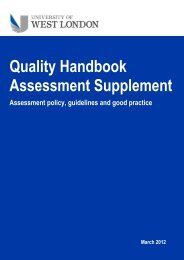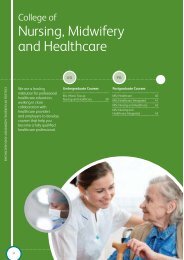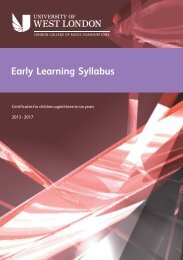Electronic keyboard and organ repertoire list - University of West ...
Electronic keyboard and organ repertoire list - University of West ...
Electronic keyboard and organ repertoire list - University of West ...
You also want an ePaper? Increase the reach of your titles
YUMPU automatically turns print PDFs into web optimized ePapers that Google loves.
<strong>Electronic</strong> Keyboard <strong>and</strong> Org<strong>and</strong>iplomas <strong>repertoire</strong> <strong>list</strong>1 January 2011 – 31 December 2015
ELECTRONIC KEYBOARD ANDELECTRONIC ORGAN DIPLOMAS2011-2015ContentsPageLCM Publications ............................................................................ 2Overview <strong>of</strong> LCM Diploma Structure .............................................. 3<strong>Electronic</strong> KeyboardGeneral Guidelines ......................................................................... 4DipLCM in Performance ................................................................. 5ALCM in Performance .................................................................... 6LLCM in Performance ..................................................................... 8FLCM in Performance .................................................................... 8<strong>Electronic</strong> OrganGeneral Guidelines ......................................................................... 9DipLCM in Performance ............................................................... 10ALCM in Performance .................................................................. 11LLCM in Performance ................................................................... 13FLCM in Performance .................................................................. 13IMPORTANT INFORMATION:This <strong>repertoire</strong> <strong>list</strong> should be read in conjunction with the Music Performance<strong>and</strong> Teaching Diplomas Syllabus, 2011-2015.Copies are available free <strong>of</strong> charge from LCM Examinations (tel: 020 8231 2364)or from local representatives, or on uwl.ac.uk/lcmexams.C<strong>and</strong>idates should ensure that they have checked the full requirements forthe examination in the above syllabus. Please note that this <strong>repertoire</strong> <strong>list</strong>does NOT contain full details <strong>of</strong> all examination components.This <strong>repertoire</strong> <strong>list</strong> is valid from 1 January 2011 until 31 December 2015.
LCM ExaminationsDirector <strong>of</strong> ExaminationsJohn Howard BA PhDChief Examiner in MusicPhilip Aldred BEd FLCM<strong>University</strong> <strong>of</strong> <strong>West</strong> LondonLCM ExaminationsSt Mary’s RoadEalingLondonW5 5RFtel: +44 (0)20 8231 2364fax: +44 (0)20 8231 2433email: lcm.exams@uwl.ac.ukuwl.ac.uk/lcmexams© Copyright 2011 by the <strong>University</strong> <strong>of</strong> <strong>West</strong> London, LCM ExaminationsLCM PublicationsThe following LCM Publications are relevant to this syllabus:• Performance Guide for <strong>Electronic</strong> Keyboard <strong>and</strong> Organ (LL194)• <strong>Electronic</strong> Keyboard & Organ Sample Diploma Tests (LL117)• LCM Aural H<strong>and</strong>book (LL205)• Specimen Aural Tests (LL189)LCM Publications are distributed by Music Exchange (tel: 0161 946 9301; email: mail@music-exchange.co.uk).A complete <strong>list</strong> <strong>of</strong> titles may be found on their website – www.music-exchange.co.ukA wide range <strong>of</strong> titles for <strong>Electronic</strong> Keyboard <strong>and</strong> <strong>Electronic</strong> Organ, including most <strong>of</strong> those specified in thissyllabus, is available from www.themusicpeople.co.uk2
Grade 5 TheoryDipLCM in Performance1. Performance2. Viva voce3. Sight readingDipMusLCMTheoretical DiplomaDipLCM in Teaching1. Teaching2. Presentation & demonstration<strong>and</strong> performance3. DiscussionALCM in Performance(St<strong>and</strong>ard, Option 1)ALCM in Performance(Recital, Option 1)ALCM in Performance(St<strong>and</strong>ard, Option 2)ALCM in Performance(Recital, Option 2)ALCM inTeaching1. Technical work2. Performance3. Viva voce4. Sight reading5. Aural tests1. Performance2. Essay3. Viva voce1. Technical work2. Performance3. one other component(choice <strong>of</strong> Viva/SR/Aural)1. Performance2. Viva voce1. Teaching2. Essay3. Presentation & demonstration<strong>and</strong> performance4. DiscussionLLCM in Performance(St<strong>and</strong>ard)1. Performancetwo <strong>of</strong>: 2. Programme notes3. Sight reading4. Viva voceLLCM in Performance(Recital)1. Performance2. Programme notesLLCM inTeaching1. Teaching2. Dissertation3. Presentation & demonstration4. DiscussionFLCM in Performance1. Performance2. Programme notes
<strong>Electronic</strong> Keyboard:General Guidelines1. C<strong>and</strong>idates are required to bring their own <strong>keyboard</strong> to the examination <strong>and</strong> will be expected to usethe internal speakers <strong>of</strong> the <strong>keyboard</strong>. However, external speakers may be used provided they areset up <strong>and</strong> dismantled speedily <strong>and</strong> efficiently within the time allotted for the examination.C<strong>and</strong>idates using their own <strong>keyboard</strong> should also provide a music rest, adaptor/batteries, st<strong>and</strong> <strong>and</strong>stool (if required). A table <strong>and</strong> power source will be provided. Examiners will not assist with settingup or registering the instrument.2. A modern instrument that features a range <strong>of</strong> programmable functions is expected to be used atdiploma level. These should include note <strong>and</strong> data sequencing, drum/percussion programming,programmable footswitches, accompaniment pattern/style composer, registration memory, autochord harmony <strong>and</strong> performance pads. The instrument’s accompaniment system should be able torecognise advanced chord extensions (e.g. add 9/2, major <strong>and</strong> dominant 9ths,diminished/augmented 5ths, 13ths etc) <strong>and</strong> all common chord extensions <strong>and</strong> be used in bothfingered/multi-fingered mode <strong>and</strong> full <strong>keyboard</strong>/pianist mode throughout the examination.3. The use <strong>of</strong> a sustain pedal <strong>and</strong> programmable function switches (foot switches) is required at thislevel. Secure musical dynamics <strong>and</strong> expression through the use <strong>of</strong> a dedicated expression pedal isexpected, as is the further control <strong>of</strong> expressive dynamics <strong>and</strong> tonal variations through <strong>keyboard</strong>touch.4. If the c<strong>and</strong>idate adheres to the score in a technically competent manner <strong>and</strong> gives a musicalperformance, full marks may be achieved. However, a higher level <strong>of</strong> pass can be achieved byexploiting the instrument’s musical <strong>and</strong> technological potential <strong>and</strong> by making musically creative <strong>and</strong>innovative alterations to a score or performance.5. In all diplomas, the c<strong>and</strong>idate is expected to make full use <strong>of</strong> the instrument’s facilities <strong>and</strong> shouldinclude any programmable feature that will facilitate a complete <strong>and</strong> competent performance. Musicperformed should only use on-board functions, although the use <strong>of</strong> an external data storage/retrievaldevice is permitted. The use <strong>of</strong> commercially available MIDI files or backing tracks is only permittedif the full potential <strong>of</strong> the instrument has been realised <strong>and</strong> the desired effect cannot be achieved byany other means. Permission to use these must be sought from the Chief Examiner in Music inadvance <strong>of</strong> the examination, <strong>and</strong> his approval letter must be brought to the exam.6. Scales <strong>and</strong> arpeggios should be played using a clear tone – preferably a piano or electric pianovoice, with no sustain. Scales should be played with a sense <strong>of</strong> musicality <strong>and</strong> purpose. The first aim<strong>of</strong> playing scales/arpeggios is to achieve accuracy, evenness <strong>and</strong> clarity. For the guidance <strong>of</strong>c<strong>and</strong>idates the recommended tempo range is shown. However, it should be remembered thataccuracy <strong>and</strong> clarity are more important than pure speed. All scales/arpeggios must be played frommemory. A copy <strong>of</strong> the music may be used for the ALCM exercise.7. ‘Single Finger’ chord recognition should only be used to create a specific effect <strong>and</strong> the examinermay ask the c<strong>and</strong>idate to justify its use.8. Copies <strong>of</strong> all music performed should be provided for the examiner, including own compositions,arrangements <strong>and</strong> sequencer scores. These may be h<strong>and</strong>-written or prepared with a score-writingcomputer programme such as Finale or Sibelius.9. The c<strong>and</strong>idate must be able to demonstrate that any sequenced data or programmed function orfeature was executed by him/her.Grateful thanks are due to Tony Pegler, the principal syllabus compiler.4
<strong>Electronic</strong> Keyboard:DipLCM in PerformancePlease refer to the syllabus for full guidelines on examination components <strong>and</strong> selection <strong>of</strong> <strong>repertoire</strong>.PerformanceRefer to the syllabus for full guidelines on the selection <strong>of</strong> <strong>repertoire</strong>. C<strong>and</strong>idates should compile a 15-20minute recital, to include the following:1. A piece from the <strong>list</strong> below, played as written, using a sound <strong>and</strong> style <strong>of</strong> your choiceARLEN One For My Baby from 101 Sinatra Hits for Buskers (Wise / Music Sales)BACHARACH I Say a Little Prayer from 50+ Rock & Pop Hits for Buskers: The Red Book(Wise / Music Sales)GADE Jealousy from 101 Latin Hits for Buskers (Wise / Music Sales)JOBIM Desifinado from The Gig Book: Jazz (Wise / Music Sales)MANCINI The Pink Panther Theme from 101 Hits for Buskers Book 6 (Wise / Music Sales)NICHOLAS Just The Way I’m Feeling from 21 st Century Rock: Buskers (Wise / Music Sales)SONDHEIM Being Alive from 101 Showtunes for Buskers (Wise / Music Sales)2. A lead sheet arrangement3. A partially sequenced arrangement <strong>of</strong> a classical theme performed in a non-classical style4. One further own choice item (if time permits)Viva VoceRefer to the syllabus for full guidelines. In addition, c<strong>and</strong>idates should be prepared to answer questionson the technical capabilities <strong>and</strong> functions <strong>of</strong> their instrument, including voice <strong>and</strong> registration settings,<strong>and</strong> to discuss the musical <strong>and</strong> technical aspects <strong>of</strong> any creative alterations made to the <strong>repertoire</strong>performed.Chord Sequence or Accompanying Test (in lieu <strong>of</strong> Sight Reading)C<strong>and</strong>idate to select ONE <strong>of</strong> the following (before the tests are seen):1. Chord Sequence Test: A written chord sequence <strong>of</strong> 8 bars will be provided, using chord symbols.The c<strong>and</strong>idate may play through the sequence once. They will then be asked to play it adding animprovised melody line. The performance may be given with or without the use <strong>of</strong> a rhythm unit.Please refer to the LCM Sample Diploma Tests book.2. Accompanying Test: An 8 bar piece will be provided written for right h<strong>and</strong> treble clef, left h<strong>and</strong>bass clef, with chord symbols. A melody will also be written for the examiner to play. The c<strong>and</strong>idatemay look at the piece, then <strong>list</strong>en to the examiner play the melody at a designated tempo. Thec<strong>and</strong>idate will then accompany the examiner as he/she plays the melody once more. Theaccompaniment may consist <strong>of</strong> left h<strong>and</strong> chords only, or may pick up some detail from bass clefreading, or may also include a right h<strong>and</strong> counter-melody. Higher marks will be awarded for a moreeffective accompaniment. The test will take place without the use <strong>of</strong> the rhythm unit. Please refer tothe LCM Sample Diploma Tests book.5
<strong>Electronic</strong> Keyboard:ALCM in PerformancePlease refer to the syllabus for full guidelines on examination components <strong>and</strong> selection <strong>of</strong> <strong>repertoire</strong>.Technical WorkSCALES, ARPEGGIOS AND CHORDSTo be played from memory, in the following keysC, G, B, F#, F, Eb, Ab, DbThe examiner will ask for a scale, followed by an arpeggio <strong>and</strong> a selection <strong>of</strong> chords in the same key.Any <strong>of</strong> the scale, arpeggio <strong>and</strong> chord types <strong>list</strong>ed below may be asked.ScalesRecommended tempo: m.m. crotchet = 174 - 180 when played in quaversAll to be played straight or swung as directed by the examiner3 octaves, h<strong>and</strong>s togetherMajorHarmonic minorMelodic minorChromatic similar motionPentatonic majorBlues62 octavesContrary motion: MajorHarmonic minorChromaticArpeggiosRecommended tempo: m.m. crotchet = 120 - 130 when played in quaversTo be played straight, 3 octaves, h<strong>and</strong>s togetherMajorMinorDiminished 7thDominant 7thChordsThe examiner will ask for chords from the <strong>list</strong> below, <strong>and</strong> may check the <strong>keyboard</strong>’s screen for accuracy:6sus4m7b5dimadd9m66/9mM7m7b913mM7b9m6/9ALCM c<strong>and</strong>idates are expected to demonstrate a clear underst<strong>and</strong>ing <strong>of</strong> various types <strong>of</strong> chords <strong>and</strong> inwhich inversions <strong>and</strong> accompaniment modes they are obtainable. At this level, most <strong>keyboard</strong>s willrecognise these chords in either ‘fingered’, ‘full <strong>keyboard</strong> / pianist’ or ‘on-bass’ mode <strong>and</strong> the c<strong>and</strong>idateshould have an underst<strong>and</strong>ing <strong>of</strong> these modes <strong>and</strong> their use.It is understood that not all <strong>keyboard</strong>s recognise all chords, therefore the c<strong>and</strong>idate must provide themanufacturer’s chord recognition <strong>list</strong> for the examiners’ reference.EXERCISEPlaying one right h<strong>and</strong> scale with left h<strong>and</strong> chord accompaniment as found in the LCM Sample DiplomaTests book. The music may be used.
PerformanceRefer to the syllabus for full guidelines on the selection <strong>of</strong> <strong>repertoire</strong>, including programme length. Referto ‘General Guidelines’ above for further information.There is no set <strong>list</strong>. C<strong>and</strong>idates should compile a recital including the following:1. An ‘own choice’ piece in a style other than classical, to include an improvised melodic solo2. A themed medley <strong>of</strong> at least four pieces3. A fully sequenced short orchestral piece in a classical style4. Further own choice items (if time permits)Viva VoceRefer to the syllabus for full guidelines. In addition, c<strong>and</strong>idates should be prepared to answer questionson the technical capabilities <strong>and</strong> functions <strong>of</strong> their instrument, including voice <strong>and</strong> registration settings,<strong>and</strong> to discuss the musical <strong>and</strong> technical aspects <strong>of</strong> any creative alterations made to the <strong>repertoire</strong>performed.Chord Sequence or Accompanying Test (in lieu <strong>of</strong> Sight Reading)C<strong>and</strong>idate to select ONE <strong>of</strong> the following (before the tests are seen):1. Chord sequence test: A written chord sequence <strong>of</strong> 8 bars will be provided, using chord symbols.The c<strong>and</strong>idate may play through the sequence once. They will then be asked to play it adding animprovised melody line. The performance may be given with or without the use <strong>of</strong> a rhythm unit.Please refer to the LCM Sample Diploma Tests book.2. Accompanying test: An 8 bar piece will be provided written for right h<strong>and</strong> treble clef, left h<strong>and</strong> bassclef, with chord symbols. A melody will also be written for the examiner to play. The c<strong>and</strong>idate maylook at the piece, then <strong>list</strong>en to the examiner play the melody at a designated tempo. The c<strong>and</strong>idatewill then accompany the examiner as he/she plays the melody once more. The accompaniment mayconsist <strong>of</strong> left h<strong>and</strong> chords only, or may pick up some detail from bass clef reading, or may alsoinclude a right h<strong>and</strong> counter-melody. Higher marks will be awarded for a more effectiveaccompaniment. The test will take place without the use <strong>of</strong> the rhythm unit. Please refer to the LCMSample Diploma Tests book.7
<strong>Electronic</strong> Keyboard:LLCM in PerformancePlease refer to the syllabus for full guidelines on examination components <strong>and</strong> selection <strong>of</strong> <strong>repertoire</strong>.PerformanceRefer to the syllabus for full guidelines on the selection <strong>of</strong> <strong>repertoire</strong>, including programme length. Referto ‘General Guidelines’ above for further information.There is no set <strong>list</strong>. C<strong>and</strong>idates should compile a recital including the following:1. A fully orchestrated piece in an orchestral style with at least two contrasting movements2. A live (non data-sequenced) performance <strong>of</strong> a contemporary pop/chart piece. This must includean instrumental (a solo instrument on your <strong>keyboard</strong>) or vocal solo <strong>of</strong> at least 16 bars, performedby the c<strong>and</strong>idate.3. A rhythmic piece using any style in ‘full <strong>keyboard</strong>’ mode <strong>and</strong> featuring any kind <strong>of</strong> piano or guitarsound.4. Further own choice items (if time permits)Viva VoceRefer to the syllabus for full guidelines. In addition, c<strong>and</strong>idates should be prepared to answer questionson the technical capabilities <strong>and</strong> functions <strong>of</strong> their instrument, including voice <strong>and</strong> registration settings,<strong>and</strong> to discuss the musical <strong>and</strong> technical aspects <strong>of</strong> any creative alterations made to the <strong>repertoire</strong>performed.<strong>Electronic</strong> Keyboard:FLCM in PerformancePlease refer to the syllabus for full guidelines on examination components <strong>and</strong> selection <strong>of</strong> <strong>repertoire</strong>.NB. Programme notes should make particular reference to the use <strong>of</strong> the technical features <strong>of</strong> theinstrument, in relation to each piece performed.8
<strong>Electronic</strong> Organ:General Guidelines1. C<strong>and</strong>idates are responsible for ensuring that an instrument is available at the examination centre,which may mean bringing their own. They will normally be expected to use the internal speakers <strong>of</strong>the instrument. However, external speakers may be used provided they are set up <strong>and</strong> dismantledspeedily <strong>and</strong> efficiently within the time allotted for the examination. C<strong>and</strong>idates using their owninstrument should also provide any additional items <strong>of</strong> equipment including a stool. A power sourcewill be provided. Examiners will not assist with setting up or registering the instrument.2. If the c<strong>and</strong>idate adheres to the score in a technically competent manner <strong>and</strong> gives a musicalperformance, full marks may be achieved. However, if the c<strong>and</strong>idate wishes to be creative bymaking natural <strong>and</strong> musical alterations to the score, he/she is encouraged to do so as long as theessence <strong>of</strong> the piece <strong>and</strong> technical st<strong>and</strong>ard are maintained.3. The c<strong>and</strong>idate is encouraged to exploit the potential <strong>of</strong> his/her instrument to the full, by making use<strong>of</strong> today’s technology <strong>and</strong> any facilities available on the instrument. This may include the use <strong>of</strong> prerecordedbacking tracks, sequencing (multi-tracking), drum <strong>and</strong> accompaniment programming, <strong>and</strong>performance (multi) pads. However, this is entirely optional, <strong>and</strong> no additional marks are availablefor the use <strong>of</strong> such technology. Any pre-recorded material must be the work <strong>of</strong> the c<strong>and</strong>idate, <strong>and</strong>must be used to enhance the live performance – not to make this technically easier.4. The use <strong>of</strong> commercially available MIDI files or backing tracks is only permitted if the full potential <strong>of</strong>the instrument has been realised <strong>and</strong> the desired effect cannot be achieved by any other means.Permission to use these must be sought from the Chief Examiner in Music in advance <strong>of</strong> theexamination, <strong>and</strong> his approval letter must be brought to the exam.5. Scales <strong>and</strong> arpeggios should be played using a clear tone – preferably a piano or electric pianovoice, with no sustain. Scales should be played with a sense <strong>of</strong> musicality <strong>and</strong> purpose. The first aim<strong>of</strong> playing scales/arpeggios is to achieve accuracy, evenness <strong>and</strong> clarity. For the guidance <strong>of</strong>c<strong>and</strong>idates the recommended tempo range is shown. However, it should be remembered thataccuracy <strong>and</strong> clarity are more important than pure speed. All scales/arpeggios must be played frommemory. A copy <strong>of</strong> the music may be used for the scale/chord exercise.6. Copies <strong>of</strong> all the music should be provided for the examiner, including own compositions <strong>and</strong>arrangements.Grateful thanks are due to Janet Dowsett, the principal syllabus compiler.9
<strong>Electronic</strong> Organ:DipLCM in PerformancePlease refer to the syllabus for full guidelines on examination components <strong>and</strong> selection <strong>of</strong> <strong>repertoire</strong>.PerformanceRefer to the syllabus for full guidelines on the selection <strong>of</strong> <strong>repertoire</strong>. The own choice item may be in theform <strong>of</strong> a single piece, segue or medley. Refer to ‘General Guidelines’ above for further information.BAGA Bagatelle for Organ (Stainer & Bell)BIZET Flower Song from Carmen from Opera Gala Book 3 (Stainer & Bell)JOPLIN The Cascades from Scott Joplin for Organ: Great Performers’ Edition(ed. E. Power Biggs)(G. Schirmer / Music Sales)MORDISH Turkish Delight (Stainer & Bell)OGDEN Mr Mozart Takes a Sleigh Ride (Stainer & Bell)Viva VoceRefer to the syllabus for full guidelines. In addition, c<strong>and</strong>idates should be prepared to answer questionson the technical capabilities <strong>and</strong> functions <strong>of</strong> their instrument, including voice <strong>and</strong> registration settings,<strong>and</strong> to discuss the musical <strong>and</strong> technical aspects <strong>of</strong> any creative alterations made to the <strong>repertoire</strong>performed.Chord Sequence or Accompanying Test (in lieu <strong>of</strong> Sight Reading)C<strong>and</strong>idate to select ONE <strong>of</strong> the following (before the tests are seen):1. Chord sequence test: A written chord sequence <strong>of</strong> 8 bars will be provided, using chord symbols.The c<strong>and</strong>idate may play through the sequence once. They will then be asked to play it adding animprovised melody line. The performance may be given with or without the use <strong>of</strong> a rhythm unit.Please refer to the LCM Sample Diploma Tests book.2. Accompanying test: An 8 bar piece will be provided written for right h<strong>and</strong> treble clef, left h<strong>and</strong>bass clef, with chord symbols. A melody will also be written for the examiner to play. The c<strong>and</strong>idatemay look at the piece, then <strong>list</strong>en to the examiner play the melody at a designated tempo. Thec<strong>and</strong>idate will then accompany the examiner as he/she plays the melody once more. Theaccompaniment may consist <strong>of</strong> left h<strong>and</strong> chords only, or may pick up some detail from bass clefreading, or may also include a right h<strong>and</strong> counter-melody. Higher marks will be awarded for a moreeffective accompaniment. The test will take place without the use <strong>of</strong> the rhythm unit. Please refer tothe LCM Sample Diploma Tests book.10
<strong>Electronic</strong> Organ:ALCM in PerformancePlease refer to the syllabus for full guidelines on examination components <strong>and</strong> selection <strong>of</strong> <strong>repertoire</strong>.Technical WorkSCALES AND ARPEGGIOSTo be played from memory, in the following keysC, G, B, F#, F, Eb, Ab, DbScalesRecommended tempo: m.m. crotchet = 174 - 180 when played in quaversAll to be played straight or swung as directed by the examiner3 octaves, h<strong>and</strong>s togetherMajorHarmonic minorMelodic minorChromatic similar motionPentatonic majorBlues2 octavesContrary motion: MajorHarmonic minorChromaticArpeggiosRecommended tempo: m.m. crotchet = 120 - 130 when played in quaversTo be played straight, 3 octaves, h<strong>and</strong>s togetherMajorMinorDiminished 7thDominant 7thEXERCISEPlaying one right h<strong>and</strong> scale with left h<strong>and</strong> chord accompaniment as found in the LCM Sample Diploma Testsbook.PEDAL EXERCISEPlaying one pedal exercise as found in the LCM Sample Diploma Tests book, <strong>and</strong> chosen by the examiner.PerformanceRefer to the syllabus for full guidelines on the selection <strong>of</strong> <strong>repertoire</strong>, including programme length. Referto ‘General Guidelines’ above for further information.There is no set <strong>list</strong>. C<strong>and</strong>idates should compile a recital including the following:1. An ‘own choice’ piece in a Latin, Jazz or Big B<strong>and</strong> style, to include a live <strong>keyboard</strong> percussionsolo <strong>of</strong> not less than 32 bars.2. A medley <strong>of</strong> the c<strong>and</strong>idate’s own devising.3. A film soundtrack, devised by the c<strong>and</strong>idate, to accompany a synopsis <strong>of</strong> the c<strong>and</strong>idate’s owndevising. The synopsis must be presented to the examiners.11
Chord Sequence or Accompanying Test (in lieu <strong>of</strong> Sight Reading)C<strong>and</strong>idate to select ONE from the following (before the tests are seen):1. Chord sequence test: A written chord sequence <strong>of</strong> 8 bars will be provided, using chord symbols.The c<strong>and</strong>idate may play through the sequence once. They will then be asked to play it adding animprovised melody line. The performance may be given with or without the use <strong>of</strong> a rhythm unit.Please refer to the LCM Sample Diploma Tests book.2. Accompanying test: An 8 bar piece will be provided written for right h<strong>and</strong> treble clef, left h<strong>and</strong>bass clef, with chord symbols. A melody will also be written for the examiner to play. The c<strong>and</strong>idatemay look at the piece, then <strong>list</strong>en to the examiner play the melody at a designated tempo. Thec<strong>and</strong>idate will then accompany the examiner as he/she plays the melody once more. Theaccompaniment may consist <strong>of</strong> left h<strong>and</strong> chords only, or may pick up some detail from bass clefreading, or may also include a right h<strong>and</strong> counter-melody. Higher marks will be awarded for a moreeffective accompaniment. The test will take place without the use <strong>of</strong> the rhythm unit. Please refer tothe LCM Sample Diploma Tests book.12
<strong>Electronic</strong> Organ:LLCM in PerformancePlease refer to the syllabus for full guidelines on examination components <strong>and</strong> selection <strong>of</strong> <strong>repertoire</strong>.PerformanceRefer to the syllabus for full guidelines on the selection <strong>of</strong> <strong>repertoire</strong>, including programme length. Referto ‘General Guidelines’ above for further information.There is no set <strong>list</strong> for LLCM in <strong>Electronic</strong> Organ. C<strong>and</strong>idates should present a recital including a widerange <strong>of</strong> own choice music <strong>and</strong> arrangements. The technical <strong>and</strong> musical potential <strong>of</strong> the instrumentshould be exploited to the full. The recital should comprise music in a wide variety <strong>of</strong> styles (includingpop, jazz <strong>and</strong> classical-based <strong>repertoire</strong>), keys, tempos <strong>and</strong> registrations. Pieces may be single items,segues/medleys, or a combination.Viva VoceRefer to the syllabus for full guidelines. In addition, c<strong>and</strong>idates should be prepared to answer questionson the technical capabilities <strong>and</strong> functions <strong>of</strong> their instrument, including voice <strong>and</strong> registration settings,<strong>and</strong> to discuss the musical <strong>and</strong> technical aspects <strong>of</strong> any creative alterations made to the <strong>repertoire</strong>performed.<strong>Electronic</strong> Organ:FLCM in PerformancePlease refer to the syllabus for full guidelines on examination components <strong>and</strong> selection <strong>of</strong> <strong>repertoire</strong>.PerformanceRefer to the syllabus for full guidelines on the selection <strong>of</strong> <strong>repertoire</strong>. Refer to ‘General Guidelines’ abovefor further information.June 201113


